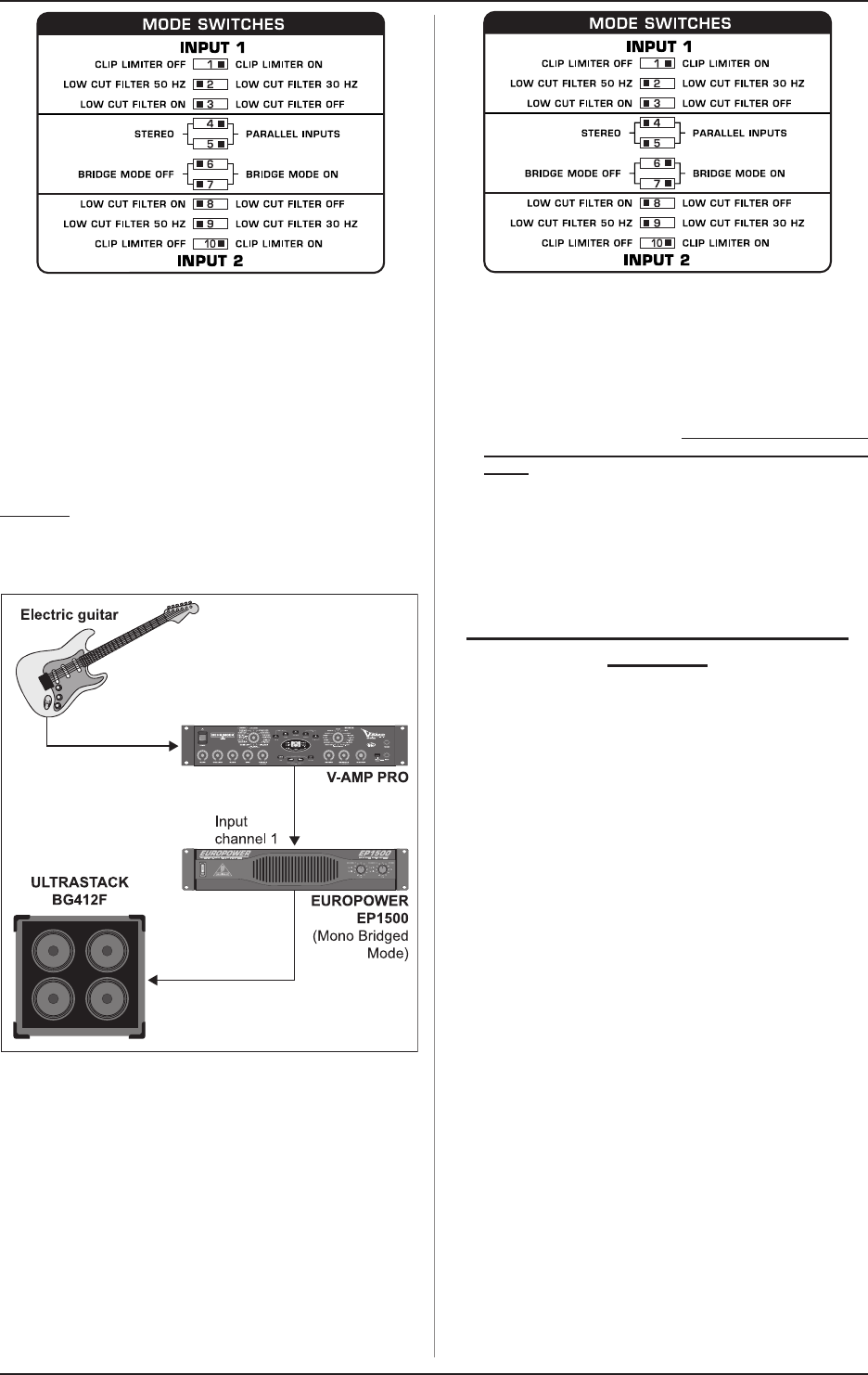
8
EUROPOWER EP1500/EP2500
3. APPLICATIONS
Fig. 3.4: DIP switch positions for parallel operation
When running in mono-bridged mode, the voltage of both
channels is added up and fed into a single loudspeaker system.
There is one input and one output signal respectively, and only
the controls of channel 1 (and not of channel 2) are used.
+ However, should the DIP switches 4 and 5 still be
in PARALLEL INPUTS position while in mono-
bridged mode, the signal on the free input (input
channel 2) can be forwarded to an additional amp.
Examples:
s Driving a single 8-Ohm loudspeaker.
s Driving a single 4-Ohm loudspeaker.
Fig. 3.5: Mono-bridged mode
Fig. 3.6: DIP switch positions for mono-bridged mode
+ When the amp is overdriven for longer periods of
time, the output signal may occasionally be muted
for several seconds. In certain situations,
excessive overdriving may trigger off the
automated fuse. To avoid overdriving the amp,
please continually make sure that an appropriate
volume level is applied. CAUTION: 2-Ohm loads
should never be applied when in mono-bridged
mode.
+ When connecting a balanced input signal, please
make sure to exclusively use balanced cables for
passing the signal further on. Otherwise, a single
unbalanced cable can turn the entire signal
unbalanced.
Safety precautions for mono-bridged
operation
Running your amp in mono-bridged mode can quickly
result in excessive overdriving and premature shutting
down of the unit itself. In the worst-case scenario, your
loudspeakers may be damaged permanently. Therefore,
you should always make sure that the speakers you use
can indeed handle the power load fed into them.
A voltage of up to 100 V RMS is present between the
output connectors of the EP2500. Always implement
appropriate safety precautions when connecting your
speakers to avoid the risk of electric shock.
3.2 Bi-amping
By using an active crossover, you can divide up the frequency
range into several bands. For example, in doing so you can split
a mono signal into upper-frequency and lower-frequency ranges.
These two signals can then be hooked up to the inputs of your
amp, so that channel 1 amplifies the lows and channel 2 amplifies
the highs (2-channel operation). The outputs are connected to a
2-way speaker, whereby the output signal 1 drives the woofer
and output signal 2 runs the drivers. Of course, you can use two
separate speakers instead of a single 2-way speaker.
A stereo signal can also be split up analogous to the example
described above. However, to do that you need two 2-way
speakers or 4 separate speakers, two EUROPOWER amps and
an active 2-way stereo crossover. The BEHRINGER SUPER-X
PRO CX2310 is optimally suited for this task and offers
additionally a single mono-subwoofer output. By deploying a
third EP1500 amp (preferably in mono-bridged mode) and a
subwoofer, you have a perfect setup that adds a low-frequency
system to the stereo bi-amp application (see fig. 3.4). The amps
input filters for the high/mid-frequency ranges should in this
case be engaged and set at 50 Hz. To remove low, disturbing
frequencies from the signal, the input filter for the subwoofer
signal should be set at 30 Hz.














